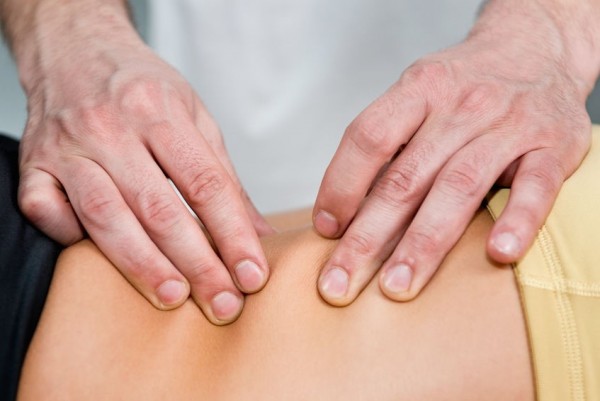
 Myofascial comes from the word fascia, which is a strong connective tissue that is web-like and runs throughout the entire body surrounding every muscle, bone, nerve blood vessel, and organ on a cellular level. You have seen it before if you have skinned a chicken breast. It is the whitish-colored thin sheets of tissue between the skin and muscle of the meat.
Myofascial comes from the word fascia, which is a strong connective tissue that is web-like and runs throughout the entire body surrounding every muscle, bone, nerve blood vessel, and organ on a cellular level. You have seen it before if you have skinned a chicken breast. It is the whitish-colored thin sheets of tissue between the skin and muscle of the meat.
Myofascial release is very different from a massage because it fixes restrictions in the fascia that are causing you pain. It's a long-term pain relief solution, not a quick, temporary fix.
 Commonly massage therapists will practice it. You also might find chiropractors, osteopathic physicians, physical or occupational therapists, sports/medicine injury specialists, or traditional medical practitioners who offer it. A good therapist will have completed extensive training and courses in myofascial release. The John F. Barnes Myofascial Release Approach is considered the best myofascial release therapy for being safe, gentle, and effective.
Commonly massage therapists will practice it. You also might find chiropractors, osteopathic physicians, physical or occupational therapists, sports/medicine injury specialists, or traditional medical practitioners who offer it. A good therapist will have completed extensive training and courses in myofascial release. The John F. Barnes Myofascial Release Approach is considered the best myofascial release therapy for being safe, gentle, and effective.
You can find a myofascial release therapist in your area through these sites:
Therapists will usually massage and stretch out a broad area of muscles and tissues in order to find these trigger points. Pain can also come from the skeletal muscle or connective tissues that are being bound by the tight fascia. These soft tissue restrictions in the fascia can inhibit blood flow.
Fascia is responsible for covering and isolating the muscles of the body, providing protection along with structural support. It surrounds every muscle, bone, nerve, and artery, along with internal organs. The entire body is connected by fascia.
 This treatment targets not only one area, but the body as a whole through the fascia. It will treat tightness of tissues that restrict motion or pull the body out of alignment. For example, if you are utilizing one hip or shoulder more than the other one. Additionally, it will relieve excessive pressure on muscles or joints that cause pain. The pain could be in just about any area of the body. Moreover, myofascial release is used as a complement to other treatments such as manipulation, acupuncture, physical therapy, or occupational therapy.
This treatment targets not only one area, but the body as a whole through the fascia. It will treat tightness of tissues that restrict motion or pull the body out of alignment. For example, if you are utilizing one hip or shoulder more than the other one. Additionally, it will relieve excessive pressure on muscles or joints that cause pain. The pain could be in just about any area of the body. Moreover, myofascial release is used as a complement to other treatments such as manipulation, acupuncture, physical therapy, or occupational therapy.
When one experiences physical trauma, emotional trauma, scarring, surgery or inflammation the fascia loses its pliability and restrictions begin to accumulate over time. These myofascial restrictions start to exert abnormal pressure on the bones, joints, nerves, blood vessels and organs which unbalance the system and create pain both locally and in seemingly unrelated areas of the body. Restrictive tissue has the ability to create up to 2,000 pounds of pressure on a single nerve. Often, the true cause of pain is overlooked by conventional medical practitioners because fascia does not show up on ordinary diagnostic tests. (Northside Myofascial Release)
Many people find myofascial release therapy helpful in treating injuries that cause a loss of flexibility or function following an injury. It can also be a result of post-surgical scarring, poor posture, trauma, or repetitive movements. However, it can help anyone experiencing ongoing back, shoulder, hip, or other pain in soft tissue areas.
Conditions it has been shown to help with include: Adhesions, Athletic Injuries, Auto Accidents, Back Pain, Bursitis, Carpal Tunnel Syndrome, Chronic Pain, Disc Problems, Fatigue, Fibromyalgia, Gastrointestinal Issues, Head Trauma, Jaw Pain, Lymphedema, Mastectomy Pain, Migraine Headaches, Muscle Pain, Myofascial Pain Syndrome, Temporo-Mandibular Joint Disorder (TMJ), Sciatica, and Venous Insufficiency.
 It is simply a therapist strategically applying sustained pressure to tight little knots. It could cause some discomfort or pain during a session, but it should ultimately decrease pain by returning the body to a regular state of balance and alignment.
It is simply a therapist strategically applying sustained pressure to tight little knots. It could cause some discomfort or pain during a session, but it should ultimately decrease pain by returning the body to a regular state of balance and alignment.
It might not be an ideal choice of therapy for people with the following conditions; burns, painful wounds, fractures or broken bones, fragile or weak bones, deep vein thrombosis or deep vein issues.
They will also determine the degree of loss of motion and symmetry. The therapist will then use their hands, palms, knuckles, or elbows and apply moderate to gentle pressure to your skin.
Sessions are typically 30 minutes to 60 minutes long. You may come in twice a week, once a week, or bi-weekly depending on the severity of your condition. Depending on the intensity of the problem, it could take anywhere from a few weeks to months to resolve the problem.
A Rumble Roller is a foam, tube shaped object that you roll under you to massage tense muscles in the body. Self-Myofascial release has become popular for both athletes and fitness enthusiasts. View some exercises for self-myofascial release on Sports Fitness Advisor.
View some tips on the Do’s and Don’ts of self-myofascial release on Livestrong.com.
 Dr. Ida Rolf in the 1950s created her own version of it involving manipulation of soft tissues and muscles. She found how the right manipulation of body structures would improve posture and function. However, the exact phrase "myofascial release" was actually coined in the 1960s by Robert Ward, an osteopath who studied with Ida Rolf. Robert Ward and physical therapist John Barnes are considered the founders of it. Today, John Barnes is internationally recognized as the leading authority on myofascial release therapy. With over 50 years of experience, John has trained over 100,000 physicians and therapists on how to use myofascial release.
Dr. Ida Rolf in the 1950s created her own version of it involving manipulation of soft tissues and muscles. She found how the right manipulation of body structures would improve posture and function. However, the exact phrase "myofascial release" was actually coined in the 1960s by Robert Ward, an osteopath who studied with Ida Rolf. Robert Ward and physical therapist John Barnes are considered the founders of it. Today, John Barnes is internationally recognized as the leading authority on myofascial release therapy. With over 50 years of experience, John has trained over 100,000 physicians and therapists on how to use myofascial release.
Most studies focus on massage or chiropractic manipulation and not myofascial release therapy specifically. This is because therapies differ from one practitioner to another. So there are very few studies to back up its effectiveness, but at the same time there are no studies disproving it either. However, there are sound theories as to why myofascial therapy works from the researchers at the FIMM International Academy of Manual/Musculoskeletal Medicine.
Ganfield, Lisa. (2009 August 6th). SPINE-Health/Myofascial Release Therapy. Retrieved from:
https://www.spine-health.com/treatment/physical-therapy/myofascial-release-therapy
Holland, Kimberly. (2015 January 26th). Healthline/What Is My Myofascial Release and Does It Work?.
Retrieved from:
https://www.healthline.com/health/chronic-pain/myofascial-release
AMEL. (2017 December 28th). Back Pain Solutions Online/The Evidence On Myofascial Release. Retrieved from:
http://backpainsolutionsonline.com/announcements-and-releases/back-pain-therapy/low-back-pain-treatment/the-evidence-on-myofascial-release
Northside Myofascial Release/Myofascial Release Therapy. Retrieved from:
http://www.myofascialreleaseatlanta.com/myofascial-release.html
Myofascial Pain Syndrome/Myofascial Therapy. Retrieved from:
https://www.myofascial-pain-syndrome.org/myofascial-therapy/
Kirwan Clinic/Myofascial Release – what to expect. Retrieved from:
http://physicaltherapytreatment.ie/myofascial-release-what-to-expect-2/
Myofascial Release Treatment Centers & Seminars. Retrieved from:
https://www.myofascialrelease.com/about/
